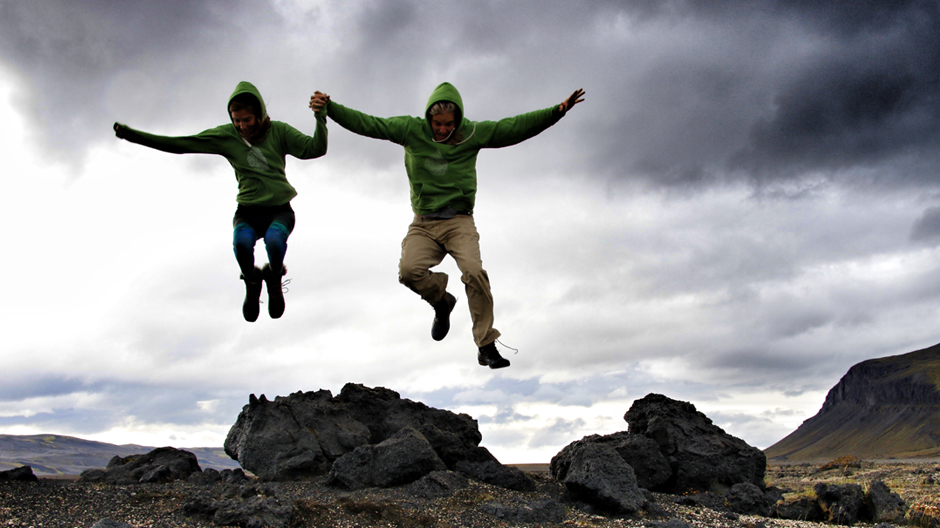Waterlust began as an experimental project by Patrick Rynne, Ph.D. ’16, and Fiona Rynne, B.S.M.A.S. ’10, M.S. ’13, at the University of Miami’s Rosenstiel School of Marine and Atmospheric Science. Seeking to change the paradigm on conventional methods of sharing scientific findings with the world, their early days were spent learning how to use online media to engage the public with marine science in an entertaining, fun and informative way.
From a small graduate student run passion project, Waterlust has now grown to be a purpose-driven brand that creates environmentally responsible products to support marine science research and education, and media to inspire scientific curiosity and an adventurous spirit.
The duo recently partnered with CARTHE, a research team dedicated to predicting the fate of oil released into our environment to help inform and guide response teams. Together, they produced a short film that highlights a story of invention, perseverance, and success called “Drifting into the Gulf.” After the Deepwater Horizon oil spill in 2010, ocean scientists from around the world came together to study the currents in the Gulf of Mexico in new ways. After designing a new bio-degradable GPS drifter, CARTHE performed the largest ocean drifter experiment in history. The video helps to bring the community into the lab and also into the field with scientists, to clearly communicate research. After being judged by 21,000 Middle School students, “Drifting into the Gulf” won 1st Place in the Professional category.
Learn more about Patrick and Fiona Rynne in this Q & A:
Tell us about your time at University of Miami; how did you meet and begin to collaborate?
We met at the new student barbecue at the Rosenstiel School of Marine & Atmospheric Science. Fiona was beginning a Masters in Marine Affairs & Policy and I was in my second year of a Ph.D. in Applied Marine Physics. We both really loved kitesurfing and started chatting about it over beers at Wetlab. I was pretty smitten over her and asked her out on a date pretty much immediately. To this day UM feels like our home. We got married on the beach at RSMAS and continue to work on various projects there. There is something about UM’s community, its lust for life, its talent and achievement without arrogance. It’s a special place.
Waterlust is a multifaceted company; can you share the motivation and concept behind development?
When we started in 2011, the idea was to use film to capture the stories of marine science as a fun side project to our graduate studies. We wanted to present scientific research in entertaining ways and use social networks to share it around the world. We mixed in videos about watersports and different kinds of adventures to engage a broader audience. We feel that the first step in becoming an advocate for the ocean, or the environment in general, is to fall in love with it. That usually happens through sports and activities, not in a classroom. Most marine scientists we know chose their field of study because of some kind of inspiring experience early in life, like going sailing with their families or learning to SCUBA dive at summer camp. So, we think it’s important to champion those kinds of experiences in our work.
After a few years of making videos we had the idea of turning Waterlust into a brand. Our motivation was to use clothing as a conversation piece for science and conservation. Videos were great and we still make them, but we find that people watch them once and move on with their day. We only get their attention for a few minutes. Clothing had the opportunity to do more. People might wear our designs over and over, and each time they wear it creates an opportunity to think, discuss with friends and spread awareness. We call the strategy “advocate apparel” and began making clothing that’s inspired by the ocean using the most environmentally friendly methods we could find. Fiona’s sister Laura was living in New York City at the time and is a brilliant seamstress and designer. We convinced her to move to Miami and oversee the clothing business. Today apparel is our primary focus.
Why is it important to share visual stories about the environment?
We think it comes down to the question of “how do people change?” Humans can be logical and rational and emotional and irrational, depending on your mood. So simply showing data and technical findings related to an environmental topic like the death of coral reefs from ocean acidification or the demonization of sharks might not be terribly effective. A well-crafted visual story can make an audience feel something, and we find that feeling something can be more powerful than knowing something.
Tell us about your work with CARTHE and the drift card project?
CARTHE is an amazing consortium of scientists at UM that we’ve had the privilege of working with for a few years. They study oil spills and how to predict where they might go in the ocean and how they impact the ecosystem. It’s an intimidatingly complicated field of work. Their team was really supportive of us experimenting with media in different ways to communicate their research. In 2013 we did a field experiment where we used drones and dye to measure ocean currents near the beach. It was in the early days of drones and the technology wasn’t user friendly. But besides the scientific benefits, we also knew drones would be a valuable tool for filmmaking, so we forged ahead and fortunately the experiment was a success. We published a paper that documented our methods and made a film that was well received. We continued to work together and produce videos that capture their work in unorthodox ways. They are so much fun to work with, which hopefully comes across in our work together.

